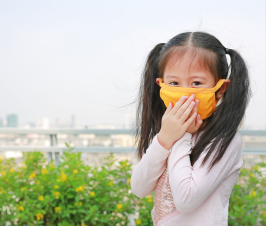Do They Belong in Our Gyms, Yoga Studios, and Daycare Centers?
Many of us are obsessed with what we put in our mouths – is it low-carb, gluten-free, good for me and allergen-free? Some of us are concerned about what we put on our bodies, as shampoos, makeup, lotions, etc. can be loaded with chemicals that are dangerous. But how about what we smell? We know air pollution or some workplace chemical odors can be harmful. But what about the pleasant fragrances wafting up to us from our air fresheners and scented candles? What could possibly be wrong with a delicate “Aromaberry” or relaxing “Forest Fresh”? Is anyone really affected by these fragrances? Why not use them in our homes, gyms, aerobic classes and yoga studios?
Breathing is one way we nourish our cells as well as detoxify. Inhalation is a common way for molecules and compounds to enter our bloodstream. We inhale to take in oxygen and exhale carbon dioxide and other waste products of metabolism. But we also bring any other compounds from the air into our bloodstream when we inhale. Smoking cigarettes or drugs, using an inhaler for your asthma or a nasal flu vaccine are examples of this.
Our sense of smell is also one way we sense danger in our environment. You might notice that if you give a toddler a new food, she will smell if before putting it into her mouth. If we smell smoke or toxic fumes, we will instinctively move away from it. The problem with synthetic fragrances is that while they are comprised of chemicals linked to cancer and other adverse health events, they are designed to “trick” our brain into thinking we are smelling something natural. Which is why we find air freshener plug-ins are named “Desert Breeze” or candles named “Salted Caramel Cappuccino”. Logically we know there is no desert breeze or salted caramel captured in the product. No company is going to name a candle “Propylene Glycol Phthalate Breeze” event though that’s exactly what it may be.
Two surveys of over 1000 people in the U.S. sheds some light on this. People were asked if they had “headaches, breathing difficulties or other problems when exposed to air fresheners or deodorizers”. The survey found that 19% of the respondents did indeed have health effects from air fresheners.1 Research has shown that fragrances are a trigger in allergies, asthma, and migraine headaches.2 Fragrances can persist in our bodies, and have been shown to be present in breast milk and accumulate in adipose tissue.2
Unfortunately, there are no governmental regulations restricting fragrances. As a preventative measure, California has enacted a law, Proposition 65, which requires the maintenance of a list of chemicals that are known to cause reproductive toxicity or cancer. Interestingly, this list contains the ingredients of certain air fresheners. 3 4
So how do manufacturers sneak these toxic chemicals into their products, you might ask. It turns out, they’ve found a legal backdoor – a “fragrance loophole” in FDA regulations – which allows manufacturers of products like air fresheners, soaps, shampoos and lotions to list any ingredient as “fragrance”, avoiding naming the actual chemical.5 This is because fragrances are trade secrets, and are regulated differently. But that leaves the consumer with having to second guess what’s in their product. For example, there is evidence that phthalates, used as a solvent/fixative in fragrances, affect the endocrine, reproductive, and immune systems.6 Phthalates are of particular risk to infants, who are exposed through breast milk, and children. Phthalates are linked to breast cancer. Exposure in children causes an increased risk of allergy and asthma and may have an adverse impact on children’s neurodevelopment.7 Some artificial musks also accumulate in breast milk and even cause cancer.5
Let’s take a look at some other evidence that fragrances in air fresheners may harm our health. Changes in DNA methylation has been shown to occur with exposure to environmental toxins, including phthalates, and household products such as hair dyes, cosmetics, and air fresheners.8 Post-mortem observation of the brains of Alzheimer’s and bipolar disorder patients reveals unusual patterns of methylation as compared to controls, with both DNA hypermethylation and hypomethylation.9 This imbalance in methylation wreaks havoc with cell synthesis and tissue damage repair. Methylation changes have even been linked to Autism.10
There are indications of other health effects as well. In animal studies, mice exposed to fragrances showed signs of neurotoxicity as evidenced by functional observational tests. 11 Some fragrances are suspected to be hormone disrupters, although this hasn’t been systematically evaluated. 2
The National Toxicology Program, which is a collaboration of scientists from multiple governmental agencies, has identified styrene, an ingredient in fragrance, and found in a wide array of products, to be “reasonably anticipated to be a human carcinogen.” 12
So it would make sense to avoid these toxic plumes released by air fresheners. Perhaps especially so when we are working out. Does your gym, yoga studio or aerobics class make use of air fresheners or scented candles?
Should we be breathing in toxic fumes when our bodies are working hard to meet our increased oxygen demand? Respiration is an important detoxification pathway, and exercise enhances your metabolism, which promotes detoxification as well. By inhaling fragrances while working out, we are nixing some of the healthy benefits we gain from exercise. Air fresheners don’t “clean” or “freshen” the air at all, they just emit fragrance to mask odors.
Children are especially susceptible to toxic environmental effects, and so we should exhibit caution with the use of air fresheners where they are exercising, in school or in daycare.
So what is our alternative when we want to mask the unpleasant odors exuding at our gyms, schools, cars or homes? We can keep the area clean, there’s a concept! Consider the use of “air purifiers” instead of “air fresheners”. If you must use an air freshener, use unadulterated essential oil products instead.
Since there is not regulation to protect you, you need to educate yourself, and speak up! If your gym or yoga or daycare center uses these compounds, take the opportunity to educate them. No one wants to be part of the cancer equations, and Prevention is the Best Cure!
 Razi Berry, Founder and Publisher of Naturopathic Doctor News & Review (ndnr.com) and NaturalPath (thenatpath.com), has spent the last decade as a natural medicine advocate and marketing whiz. She has galvanized and supported the naturopathic community, bringing a higher quality of healthcare to millions of North Americans through her publications. A self-proclaimed health-food junkie and mother of two; she loves all things nature, is obsessed with organic gardening, growing fruit trees (not easy in Phoenix), laughing until she snorts, and homeschooling. She is a little bit crunchy and yes, that is her real name.
Razi Berry, Founder and Publisher of Naturopathic Doctor News & Review (ndnr.com) and NaturalPath (thenatpath.com), has spent the last decade as a natural medicine advocate and marketing whiz. She has galvanized and supported the naturopathic community, bringing a higher quality of healthcare to millions of North Americans through her publications. A self-proclaimed health-food junkie and mother of two; she loves all things nature, is obsessed with organic gardening, growing fruit trees (not easy in Phoenix), laughing until she snorts, and homeschooling. She is a little bit crunchy and yes, that is her real name.
References:
- Caress SM, Steinemann AC. Prevalence of fragrance sensitivity in the American population. Journal of Environmental Health. 2009, 71(7):46-50.
- Bridges, B. Fragrance: emerging health and environmental concerns. Flavour Fragr. J., 2002, 17: 361–371.
- Nazaroff WW, Weschler CJ. Cleaning products and air fresheners: exposure to primary and secondary air pollutants. Atmospheric Environment. Volume 38, Issue 18, June 2004, Pages 2841–2865.
- CA.gov. Office of Environmental Health Hazard Assessment. http://oehha.ca.gov/prop65.html
- Environmental Working Group. Ask EWG: What is “fragrance”? http://www.ewg.org/enviroblog/2007/12/ask-ewg-what-fragrance
- Kastanias TV, Tokmakidis SP. The effect of phthalates as endocrine disruptors in human health. Arch Hellen Med, 29(5), September-October 2012, 539-549.
- Jurewicz J., Hanke W. Exposure to phthalates: Reproductive outcome and children health. A review of epidemiological studies. International Journal of Occupational Medicine and Environmental Health June 2011, Volume 24, Issue 2, pp 115-141.
- Whole Health Insider. http://www.wholehealthinsider.com/brain-health/alzheimers-and-autism-the-common-link/
- Rao JS, et al. Epigenetic modifications in frontal cortex from Alzheimer’s disease and bipolar disorder patients. Transl. Psychiatry. 2012 Jul 3, 2: e132.
- Nguyen A, et al. Global methylation profiling of lymphoblastoid cell lines reveals epigenetic contributions to autism spectrum disorders and a novel autism candidate gene, RORA, whose protein product is reduced in autistic brain. FASEB J. 2010 Aug, 24(8):3036-51.
- Anderson RC, Anderson JH. Acute Toxic Effects of Fragrance Products. Archives of Environmental Health: An International Journal. 1998, 53(2): 138-146. Published online Dec 11, 2012.
- Environmental Working Group. Expert Panel Confirms that Fragrance Ingredient Can Cause Cancer. http://www.ewg.org/enviroblog/2014/08/expert-panel-confirms-fragrance-ingredient-can-cause-cancer


















Is there anything I can do about being subjected to these toxic air fresheners at work all day? I have tried telling them I have a chemical sensitivity, and they seemed to understand. They said the office can smell bad in the winter, so they’ve added 2 new air fresheners. We were using an oil diffuser before, which I was happy with. No sore throat, headache, etc. Thanks.